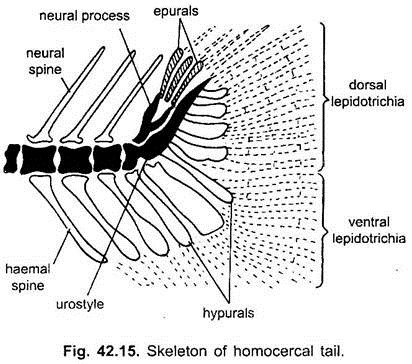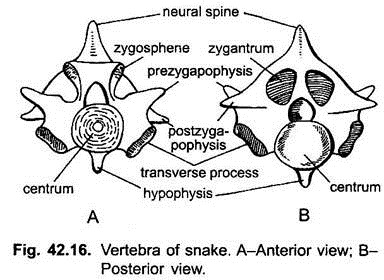The tetrapoda on emergence from water to land underwent many changes. One of these changes involved a differentiation of the vertebral column into regions. For movement of the head the anterior trunk vertebrae called cervicals had their ribs reduced.
With the formation of limbs for use on land the last few trunk vertebrae called sacrals were modified for articulation with the pelvic girdle. These sacral vertebrae bear short stout ribs for bracing the pelvic girdle against the vertebral column.
The caudal vertebrae are reduced in number, and the terminal ones are reduced to small cylindrical centra only with no arches. Thus, tetrapoda have cervical, trunk (dorsal), sacral and caudal vertebrae. In many reptiles and all birds and mammals the trunk vertebrae are further differentiated into thoracic vertebrae having ribs and lumbar vertebrae with reduced or no ribs.
(i) Amphibia:
ADVERTISEMENTS:
The centra of vertebrae are stereospondylous being formed from hypocentra, the pleurocentra having disappeared. There is a single cervical vertebra (atlas) which articulates with the skull. This is followed by trunk vertebrae, then there is a single sacral vertebra connected to pelvic girdle. Caudal vertebrae are found only in tailed forms. All caudal vertebrae, except the first, bear haemal arches with haemal spines.
(ii) Reptila:
The vertebrae are gastrocentrous, i.e., the centra are formed from pleurocentra, the hypocentrum being lost, but in Sphenodon it persists as a small ventral remnant. The vertebral column in most lizards and crocodilians is differentiated into cervical, thoracic, lumbar, sacral, and caudal regions.
In all living forms two sacral vertebrae fuse to form a sacrum whose transverse processes and ribs are attached to the pelvic girdle. Caudal vertebrae have small V-shaped chevron bones on the ventral side of centrum, they are formed from the hypocentra and are not homologous with haemal arches of lower forms in which haemal arches are formed from basiventrals.
ADVERTISEMENTS:
All types of centra are found in reptiles, in turtles and Sphenodon. They are amphicoelous, some have opisthocoelous vertebrae. Most lizards, snakes and crocodilians have procoelous vertebrae. Sacral vertebrae of crocodilians are amphiplatyan. In snakes and some lizards in addition to zygapophyses, there is a special pair of apophyses called zygosphenes at the anterior end fitting into concavities called zygantra located on the posterior side of each vertebra.
(iii) Aves:
The vertebrae are formed in typical manner from four pairs of arcualia. The chief characteristic of the vertebral column is its rigidity due to an ankylosis between vertebrae. The rigidity is an advantage in flight. The cervical region is very mobile but the other regions are capable of little movement. The vertebral column provides a fulcrum for the wing strokes.
In the cervical region the number of vertebrae is variable from 8 to 25. These vertebre are heterocoelous or saddle-shaped, the anterior face of the centrum is convex dorsoventrally, but concave from side to side, the posterior face has its curves in just the opposite direction so that there is proper articulation.
Thus, in vertical section the centrum appears opisthocoelous and in horizontal section it is procoelous. But parrots have opisthocoelous cervical vertebrae, and in Archaeopteryx they were amphicoelous. Cervical vertebrae bear short ribs, ventrally each vertebra has a hypapophysis. Thoracic vertebrae are more or less fused together, though some are free, their centra are produced below into hypapophyses, their broad transverse processes bear ribs.
ADVERTISEMENTS:
Ribs are attached to thoracic vertebrae and are united ventrally to the sternum. The posterior thoracic, lumbar, sacral, and the first few caudal vertebrae are all fused together to form a single synsacrum, which becomes fused with the pelvic girdle. The number of vertebrae making up the synsacrum varies from 13 to 20 in different birds.
On examining the ventral side of the Synsacrum the separate transverse processes of vertebrae are seen which reveal the number of vertebrae forming the synsacrum. Only two of the vertebrae of the synsacrum are sacral, except in ostrich which has three.
The synsacrum provides a rigid framework valuable in flight and the girdle with its longitudinal curvature distributes the weight of the body evenly on the legs in standing or walking. The number of caudal vertebrae is small, the first few after the synsacrum are free but the posterior ones are fused to form a pygostyle which supports the tail. The free caudal vertebrae are amphicoelous.
(iv) Mammalia:
The vertebrae are gastrocentrous. The centra being formed from pleurocentra, while the hypocentra form intervertebral discs. During development each centrum has an epiphysis at each end, except in monotremes and sirenians, the epiphyses finally fuse with the centrum. Between the centra are intervertebral discs. In front of the sacrum these discs are made of fibrocartilage with a remnant of the notochord in the centre, called nucleus pulposus.
In the sacral and caudal regions the intervertebral discs are bony. The vertebral column has cervical, thoracic, lumbar, sacral, and caudal regions. The vertebrae are amphiplatyan (acoelous), but in Perissodactyla the cervical vertebrae are opisthocoelous.
An outstanding feature is the presence of 7 cervical vertebrae in most mammals, except in some Edentata which have 6 to 9 vertebrae. In many whales, moles and armadillos the cervical vertebrae fuse together.
The atlas and axis are modified as in amniotes. Ribs are fused to cervical vertebrae. There being a vertebrarterial canal between the two heads of the rib. Behind the neck the number of vertebrae is variable in mammals. Thoracic vertebrae bear ribs which connect directly or indirectly with the sternum, but some posterior ribs do not reach the sternum and are called floating ribs.
Lumbar vertebrae are strong and longer than others. They have prominent transverse processes directed forward. The anterior lumbar vertebrae bear two additional processes called mammillary processes or metapophyses. Sacrum has several vertebrae fused together- 3 in dog, 4 in rabbit, 5 in horse, and 5 in man.
There is no sacrum in whales because of a reduced pelvic girdle. Caudal vertebrae are variable in number- 16-18 in rabbit, 20-23 in dog, 15-21 in horse, and 3-4 in man which unite to form a single coccyx. Usually the most posterior caudal vertebrae are reduced to only centra, whereas the more anterior ones possess all the parts.

